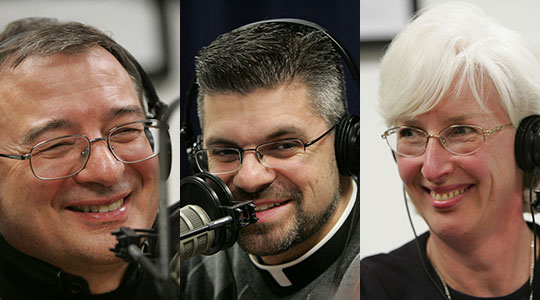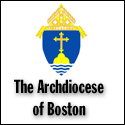Summary of today’s show: Seven years ago today, Bl. John Paul II died on the eve of the Feast of Divine Mercy, the devotion that he did so much to promote. Scot Landry and Fr. Matt Williams are joined by Fr. Kazimierz Chwalek and Mary Kay Volpone of the Association of Marian Helpers to discuss this great message of divine love, in which we are called to approach the fountain of Divine Mercy with great trust and through it renew the face of the world.
Listen to the show:
Podcast: Play in new window | Download
Today’s host(s): Scot Landry and Fr. Matt Williams
Today’s guest(s): Fr. Kazimierz Chwalek and Mary Kay Volpone of the Association of Marian Helpers
Links from today’s show:
Today’s topics: Divine Mercy
1st segment: Scot welcomed everyone to the show. He noted that today is the seventh anniversary of the death of Blessed John Paul II. They recalled where they each were on that day. Fr. Matt recalls being on a Life in the Spirit seminar in Maine. The day he died was the feast of Divine Mercy. Today we will be talking about Divine Mercy with Fr. Kaz and Mary Kay from the National Shrine of Divine Mercy in Stockbridge, Massachusetts.
2nd segment: Scot welcomed Fr. Kaz and Mary Kay to the show. Fr. Kaz said hearing about John Paul brings up all the wonderful memories. Mary Kay recalled hearing the news of the passing of John Paul, being with her nephews and nieces and explaining the importance of the moment and praying with them.
Fr. Kaz said the Holy Father actually died at 3:37 pm our time, 9:37pm in Rome, not yet the feast of Divine Mercy. Fr. Kaz said they prayed for him during the hour of Divine Mercy of 3pm. He was in the church at the shrine praying when he heard. Scot said George Weigel has written that John Paul’s love for the Divine Mercy was one of the 3 things that defined his papacy.
Fr. Kaz said when John Paul was a laborer during World War II and he used to pass by the shrine of Sr. Faustina’s convent and he was aware of the devotion even before he entered seminary. In 1965 many people wanted him to initiate the cause of Sr. Faustina as archbishop of Karakow, but the Church had banned the devotion. So at the end of Vatican II, he asked the prefect of the Holy Office what to do and he was told to begin. In November 1965, he initiated the cause. He asked one of his best theologians to write an analysis of the diary and the ban was lifted in 1978, six months before John Paul was elected pope. This allowed him to promote the cause, where before it would have been called favoritism.
In 1980, he published his second encyclical on Divine Mercy, Dives in Misericordia, where he provided the theological ground for our understanding of divine Mercy without mentioning Faustina. Fr. Kaz was born in Poland and came to the US at 13. Scot asked him to describe how central to Polish Catholicism was the Divine Mercy devotion. Fr. Kaz said once the ban was put in place, the devotion died down and nobody really knew about it in most of Poland. Prior to the ban in 1958, it was promoted and spread, especially during World War II and was a consoling message of hope. In fact, the Marians of the Immaculate Conception brought it to the United States in 1941 and it was spread more widely here. The message was given to the Marians by Faustina’s spiritual director and they began to publish it immediately. The priest had asked the Lord that if he was able to get him out of Communist Poland, that he would do all he could to spread the message.
Fr. Kaz said the Holy Father’s second papal trip was to Poland and at the time Fr. Kaz was a graduate student there. The atmosphere was still oppressive without freedom. Fr. Kaz said he will never forget the day on Pentecost when they televised the Mass nationally and John Paul cried out “Let the Holy Spirit come and renew the face of this land.” Fr. Kaz said the students left their studies and followed him for 7 days throughout Poland. Fr. Kaz had a sense of freedom. They were not afraid. This was the beginning of Solidarity. So what this message means is seeing how God works, how merciful He is, how much He cares for us. He can remove the shackles of slavery. Later on, out of that Solidarity movement came the whole collapse of European Communism.
Mary Kay said the key points of the devotion are the feast, the image, the hour, the chaplet and the hour of great mercy. She said it’s not just a devotion but a message and way of life. It’s a way of trusting in the Lord and forgiving people. She said it was essential in Poland for people to learn to forgive after the Nazi oppression and then the Communist oppression.
Fr. Matt said the Gospel proclaims the abundance of God’s mercy, so the Divine Mercy message through Faustina was not new. Yet, it beautifully unpacks and makes more accessible what we have received in the Gospel. Jesus is the first missionary. He was sent from the Father to redeem and save humanity. Fr. Kaz said the Lord in the messages wants us to know Him as He is. St. Faustina’s spiritual director talked about how much in reading the diary of St. Faustina, he rediscovered the great love and mercy of Christ. It highlights the teachings of our Church, like a spotlight on the Old Testament and New Testament. More than half the Psalms reference mercy, but we overlook it so often.
Scot said too often people see God as a tough judge, and it is true that God is our judge, but He also loves us and is merciful and wants to carry our burdens for us. Fr. Kaz said God has given us the ability to know Him and His will and when we go contrary to the commandments we know there are consequences, like the law of gravity. Even though we know, we are weak, in Original Sin, so God gave us the incredible gift of his Son, who has already freed us for eternity. He gave its the power to overcome brokenness.
3rd segment: Fr. Matt asked how we help others rediscover the sense of sin that brings us to repentance. Fr. Kaz said in our hearts we brokenness and disillusionment. While we may not be aware of the nature of sin, God in his mercy wants to heal us. Someone going through hopelessness and despair, call upon God who will come and rescue them. God does not hold grudges. He loves us so much he will takes us home if we acknowledge our need for him.
Mary Kay said St. Faustina wrote in her diary about souls striving for perfection. Jesus says there that we fall because we rely too much on our selves and not enough on him. But realize that God doesn’t provide just so many pardons. No matter how many times we turn to him with contrite hearts he will forgive us. It’s when we stop turning to him, that’s when we get in trouble. If the soul doesn’t allow even a little flicker of him in there, he will respect that choice. We have that choice to let him in.
At the crucifixion, when Jesus’ heart is pierced and blood and water flow out, it means that there is nothing left to give. It is poured out for every single one of us. No one is ever lost. If someone needs prayers, pray for them because no one is ever beyond conversion.
Fr. Kaz quoted, “I have opened My Heart as a living fountain of mercy. Let all souls draw life from it. Let them approach this sea of mercy with great trust (Diary, 1520). On the cross, the fountain of My mercy was opened wide by the lance for all souls — no one have I excluded!”
Christ is our fountain so the minute we come to him in prayer, we ask him for healing for mercy and there is more. The Holy Spirit inspires us to pray. Once we are there in that moment, then he draws us to the sacraments. The person opens their heart even a little bit and the Lord comes in. It’s not just Confession, but also the Eucharist. The Eucharist is the fountain of His Mercy. Our Lady is also the one who brings Mercy because she intercedes for us.
Scot asked about St. Faustina, who was born in 1905 and died in 1938. Mary Kay said Faustina was the third of ten children in a peasant family. Her family didn’t want her to enter religious life even though she felt a call at 7 years old. When she was 20 years old and attending a dance, she had a vision of the Lord standing before her and asking how long she was going to make him wait. She left the party, ran into a church, and asked for guidance. She was told to go to Warsaw. She got off the train and asked Our Lady for direction .She eventually ended up at the Sisters of Our Lady of Mercy who took her in. She had little education and was a gardner, porter, and cook. A beggar came to the door one day and she gave him food. When she turned around she was gone.
She started to see visions of Our Lord and write them in her diary. Her spiritual director, Blessed Michael Sopocko, had her examined by a psychiatrist and he later said that he was being so edified by the writings. Mary Kay said one of her favorite parts was Faustina talking about keeping control of an unruly tongue.
At one time, she had tuberculosis and no one believed her. The other sisters thought she was stupid and careless and didn’t know about her receiving her messages, yet she thanked God for the daily crosses and harsh way she was treated. And today as a saint she’s interceding for those us who are struggling.
Fr. Matt asked about the hour of mercy and how we can observe it. Fr. Kaz said as Catholics we used to have during Lent a remembrance of Christ’s Passion at 3pm. The Lord wanted us to remember him every day in His Passion. Wherever we are we should immerse ourselves in His Passion and to remember what He did for us. Otherwise we go about the day immersed in our present moment, but this life, this world, this moment is not everything. We can experience his love and extraordinary graces by meditating on his passion for as long as we can. He said the Chaplet of Divine Mercy is particularly important in turning to the Father and asking for graces and mercy for everyone around the world.
The chaplet is a unique prayer given by the Lord to St. Faustina which grants unimaginable graces to those who recite, especially when recited before one who is dying.
He said it’s especially useful to pray many chaplets while driving. It’s a powerful prayer because we turn to the Father. Scot said the chaplet is broadcast every day at 3pm on WQOM and CatholicTV does so as well.
Fr. Matt said it can bring comfort to those praying for loved ones who are separated from the Lord, especially when they are dying and don’t have access to a priest. We can pray and the Lord has promised to come in His mercy to that person in the hour of his death. Fr. Kaz says to pray for the dying and trust in his mercy because they have the most need of trust and have it the least.
Fr. Kaz said they often teach health care professionals, especially nurses, on the Divine Mercy because they are often the only ones who can pray for the dying.
Scot said people are often familiar with the image of Divine Mercy with the motto of Jesus, I trust in you. It’s the promise we all can have to be able to trust in Christ. This was Jesus’ signature that he requested at the bottom of the image. Mary Kay said there are other versions of the image created by artists trying o capture exactly what St. Faustina saw. But instead of getting caught up on any particular image, we should ensure it captures our heart.
This Friday begins the nine-day novena leading to the Feast of Diviune Mercy on the Sunday after Easter. Fr. Kaz said the Lord announced the feast before he asked for the novena and repeated it on numerous occasions His desire for this feast. The key element for the Lord was that it occur on the Sunday after Easter. The Eucharist is a key component of the novena as is a good confession.
Fr. Kaz said learning this message 33 years ago was the most exciting gift he’s ever received. It’s a message of renewal. Mary Kay said everyone is welcome to the Shrine of Divine Mercy on April 15. It takes place outdoors on the ground and they get between 10,000 and 20,000 pilgrims each year.








Comments Closed
Trackbacks/Pingbacks
[…] Program #0270 for Monday, April 2, 2012: Divine Mercy […]
[…] shownotes may be found on the original airdate’s show page. Divine Mercy, Fr Matt Williams, Fr. Kazimierz Chwalek, Mary Kay Volpone, Scot Landry, […]